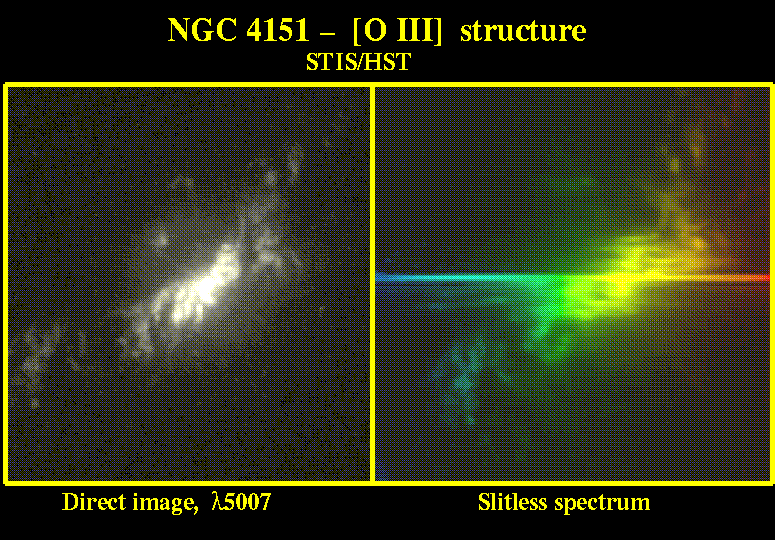
These images both depict the same area - the region of ionized gas around the nucleus of the bright Seyfert galaxy NGC 4151. In one case, the observations used a narrow-band filter to isolate the bright gaseous emission of doubly ionized oxygen - [O III] - at 5007 Angstroms, while the other used a diffraction grating to spread the light at each point into a spectrum. The color coding was used to indicate this and to show the direction of spectral dispersion, though the wavelength range spanned by the observation would not produce a vivid color range visually. The brilliant nucleus is spread into a horizontal line, producing radiation at all wavelengths in the form of a continuum.In the dispersed image, a single cloud of gas with small internal motions will have a single Doppler shift, and will have the same appearance as in the filtered image, perhaps with a position shift due to its overall Doppler shift with respect to the average. However, a parcel of gas with a large velocity dispersion, such as one might see in a turbulent situation or near a shock front, will be preferentially smeared along the wavelength direction (left-right in this depiction). Careful comparison of these two images shows that there are many such regions, mostly located in the locations close to where the galaxy's small radio jets emerge from the nucleus. These radio jets lie approximately along the axes of the twin emission-line cones. This connection between rapid local gas motions and the emerging jets has been interpreted as evidence that much of the "turbulent" motion in the outer regions of Seyfert nuclei is powered by the radio jets, as they transfer energy to their surroundings.
The emission-line image shows clearly the biconical region where most of the ionized gas appears, in support of a `beaming picture" for the various kinds of Seyfert nuclei. It poses an interesting puzzle, however, because to get this plan view we must be outside the cones, but we see the broad-line region and thus classify NGC 4151 as a type 1 Seyfert - in fact, it was the prototype of the class. Thus, there are directions outside these cones where we can have a fairly clear view of the core, so the simple mental picture of a solid torus and clear views along its axis cannot be taken quite literally.
These data were among the earliest taken with the Space Telescope Imaging Spectrograph (STIS), installed on the Hubble Space Telescope in February 1997 by the crew of the space shuttle Discovery during STS-82. These data are courtesy of John Hutchings, with a full discussion published by Hutchings et al. in Astrophysical Journal Letters 492, L115 (1998). Normal astronomical practice involves using a narrow slit to limit the area of sky being investigated and so avoid confusing overlap between spectra of different areas, but in a case like this of structure in a single strong emission line, slitless spectroscopy such as this may be very revealing and much less time-consuming than mapping the whole object with narrow slit locations. These images show a region about 12" top-to-bottom, corresponding to roughly 750 parsecs (2500 light-years) at the distance of NGC 4151.